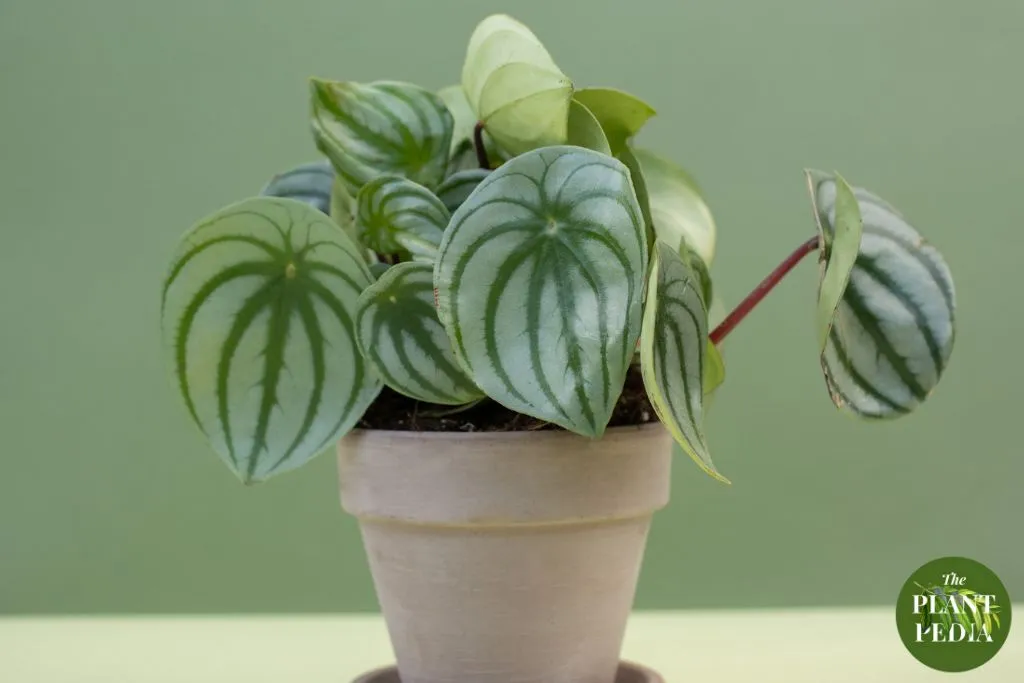The Peperomia commonly known as the Radiator Plant, stands out as a versatile and captivating choice.
With its striking foliage, compact size, and ease of care, it has gained a special place in the hearts of plant enthusiasts and beginners alike.
In this comprehensive guide, we will delve into the world of Peperomia plants, exploring their various species, care requirements, propagation techniques, and aesthetic potential.
What is a Peperomia (Radiator Plant)?
Peperomia is a diverse genus of plants that belong to the Piperaceae family, which also includes black pepper.
The Piperaceae family is a large family of flowering plants that contains over 3,600 species. The two largest genera in the family are Peperomia (over 1,000 species) and Piper (2,171 species). Other well-known members of the Piperaceae family include kava, kava kava, and cubeb.
Peperomias are native to tropical and subtropical regions around the world. They are known for their small, colorful leaves and their ability to tolerate a wide range of conditions. Many peperomias are popular houseplants, and some species are also used in traditional medicine.
Originating from tropical and subtropical regions of Central and South America, Peperomias are beloved for their unique foliage, intriguing textures, and intriguing growth habits.
The name “Radiator Plant” comes from the belief that these plants thrive in warm conditions, much like a radiator.
Also Read: 60 Peperomia Varieties (Types of Radiator Plant) For Indoor Garden.
What Do They Look Like?
Peperomia plants, commonly known as Radiator Plants, exhibit a wide range of appearances due to the diverse species within the genus.
However, there are some common characteristics that can give you an idea of what they generally look like.
Leaf Shape and Size:
Peperomia leaves come in various shapes, sizes, and textures, which is one of their defining features.
Some species have oval or heart-shaped leaves, while others have more unique shapes like round or even elongated lanceolate leaves.
The size of the leaves can range from small and delicate to larger and more substantial, depending on the specific variety.
Leaf Color and Patterns:
The colors and patterns of Peperomia leaves are quite diverse, adding to their visual appeal.
Many species have lush, vibrant green leaves that may be solid in color or feature intricate patterns.
Variegated varieties display leaves with contrasting shades of green, cream, white, or even pink.
Some species, like the Watermelon Peperomia (Peperomia argyreia), have leaves that resemble the skin of a watermelon, with silver stripes on a green background.
Leaf Texture:
One of the most intriguing aspects of Peperomia leaves is their texture.
Some varieties have smooth and glossy leaves, while others feature leaves with unique textures, such as corrugated, crinkled, or slightly waxy surfaces.
The String of Turtles (Peperomia prostrata) has leaves that resemble tiny turtle shells due to the raised pattern on their surface.
Stem Structure:
The stems of Peperomia plants can vary in color and structure. Some species have thick, succulent-like stems, while others have more delicate and slender stems.
The color of the stems can range from green to red, adding to the overall aesthetic appeal of the plant.
Growth Habit:
Peperomias exhibit different growth habits, including compact, bushy growth and trailing habits.
Some varieties grow in a rosette formation, while others develop into more upright or sprawling plants.
The growth habit of a particular Peperomia species will influence how it can be displayed and incorporated into your indoor spaces.
Flowers:
While Peperomia plants are typically grown for their foliage, some species do produce small, inconspicuous flowers.
These flowers are usually spike-like or cylindrical in shape and may vary in color depending on the species.
However, the foliage remains the primary attraction for most Peperomia enthusiasts.

Read: Peperomia Benefits: For Home and Health.
Varieties and Species:
Peperomias come in a wide range of species, each with its own distinct characteristics. Some popular varieties include:
- Peperomia obtusifolia: Also known as the Baby Rubber Plant, this variety features glossy, oval-shaped leaves that are typically green but can have variations in color, such as variegated patterns.
- Peperomia caperata: Known for its deeply wrinkled leaves, this variety has a charming crinkled appearance, often likened to the texture of corrugated cardboard. It comes in various shades of green and red.
- Peperomia argyreia: Commonly referred to as the Watermelon Peperomia, its leaves resemble the skin of a watermelon due to their green and silver-striped appearance.
- Peperomia rosso: This variety boasts striking red stems and glossy green leaves, creating a visually appealing contrast that adds a touch of elegance to any indoor space.
- Peperomia graveolens: Also known as the Ruby Glow, it features succulent-like, fleshy leaves that are a rich shade of deep red or burgundy.
- Peperomia prostrata: Nicknamed the String of Turtles, this variety has small, round leaves with intricate patterns resembling turtle shells, making it a delightful trailing plant.
Caring for Peperomia:
Peperomias are renowned for their low-maintenance nature, making them an excellent choice for both experienced and novice plant enthusiasts.
Here are some key care tips to ensure your Radiator Plant thrives:
1. Light:
Peperomias prefer bright, indirect light. While they can tolerate some lower light conditions, placing them near a window with filtered sunlight will promote healthier growth and vibrant foliage.
Avoid exposing them to harsh, direct sunlight, as it can scorch their leaves.
2. Watering:
Allow the top inch of the soil to dry out before watering. Overwatering can lead to root rot, so it’s important to maintain a balanced watering routine.
Water less frequently during the winter months when the plant’s growth slows down.
3. Humidity:
Peperomias appreciate moderate humidity levels, which can be achieved through occasional misting or placing a tray of water near the plant.
However, they can tolerate average household humidity levels as well.
4. Soil:
Use a well-draining potting mix that allows excess water to escape. Adding perlite or orchid bark to the mix can help improve drainage.
5. Temperature:
Peperomias thrive in temperatures between 65°F to 75°F (18°C to 24°C). Avoid exposing them to drafts or sudden temperature fluctuations.
6. Fertilization:
During the growing season (spring and summer), feed your Peperomia with a balanced, diluted liquid fertilizer every 4-6 weeks.
Reduce or halt fertilization during the dormant period in fall and winter.
7. Pruning:
Prune your Peperomia to encourage bushier growth and remove any yellowing or damaged leaves.
Pinching off the tips of stems can also prevent legginess and promote denser foliage.
Propagation Techniques:
Peperomias are relatively easy to propagate, allowing you to share their beauty with friends and expand your plant collection.
Here are a few common propagation methods:
1. Leaf Cuttings:
Gently remove a healthy leaf from the parent plant and allow it to air dry for a day to callous.
Place the calloused end in a well-draining potting mix and mist the soil to maintain moisture.
Over time, the cutting will develop roots and eventually grow into a new plant.
2. Stem Cuttings:
Similar to leaf cuttings, you can take stem cuttings with a few leaves attached.
Allow the cut end to callous before planting it in soil. Keep the soil consistently moist until roots form.
3. Division:
For Peperomias that have multiple stems, you can carefully divide the plant during repotting.
Gently separate the stems and root systems, then plant them in their individual pots.
Aesthetic Potential:
Beyond their easy care requirements, Peperomias offer a wide range of aesthetic possibilities for your indoor spaces.
Their unique leaf shapes, colors, and textures make them perfect candidates for various design styles.
1. Decorative Displays:
Create visually appealing displays by grouping different Peperomia varieties together.
Choose pots that complement the foliage colors and textures, and consider varying the heights for added dimension.
2. Hanging Gardens:
Trailing Peperomias like the String of Turtles can be placed in hanging planters to showcase their cascading growth habit.
These arrangements add an element of elegance to shelves, windows, or hanging baskets.
3. Terrariums:
Some Peperomia varieties, such as the Watermelon Peperomia, thrive in terrarium environments.
Their compact size and striking appearance can transform a terrarium into a captivating miniature garden.
4. Miniature Landscapes:
Larger Peperomia varieties can serve as focal points in miniature landscapes, alongside other small plants, rocks, and decorative elements.
5. Office Greenery:
Due to their adaptability to indoor conditions, Peperomias make excellent office companions, adding a touch of nature to workspaces while requiring minimal maintenance.
Related FAQs:
Peperomia is a genus of plants belonging to the Piperaceae family, originating from tropical and subtropical regions. The name “Radiator Plant” is attributed to the belief that these plants thrive in warm conditions, much like radiators in cold weather. The name reflects their preference for temperatures on the warmer side.
Peperomia plants come in a wide range of species, each with its own distinct characteristics. Some popular types include Peperomia obtusifolia, Peperomia caperata, Peperomia argyreia (Watermelon Peperomia), Peperomia rosso, Peperomia graveolens (Ruby Glow), and Peperomia prostrata (String of Turtles), among others.
Caring for Peperomia plants involves providing them with the right amount of light, water, humidity, and appropriate soil conditions. Place them in bright, indirect light, water when the top inch of soil is dry, maintain moderate humidity levels, use well-draining soil, and avoid extreme temperature fluctuations.
While Peperomias prefer bright, indirect light, they can tolerate lower light conditions. However, too much low light can lead to leggy growth and reduced vibrancy in foliage. If growing in low light, ensure the plant receives occasional exposure to brighter light to maintain its health and appearance.
Watering frequency depends on factors such as humidity, light, and the type of Peperomia. Allow the top inch of soil to dry out before watering. It’s better to underwater than overwater, as Peperomias are susceptible to root rot. Adjust your watering schedule based on the plant’s specific needs and the conditions in your environment.
Yes, Peperomias are relatively easy to propagate. You can propagate them through leaf cuttings, stem cuttings, and division. Leaf and stem cuttings should be allowed to callous before planting them in well-draining soil. Division is best done during repotting by separating multiple stems and root systems.
Like many indoor plants, Peperomias can be susceptible to pests such as mealybugs, spider mites, and aphids. Regularly inspect your plants for signs of pests, and if you spot any, isolate the affected plant and treat it promptly with insecticidal soap or neem oil. Quarantine new plants before introducing them to your collection to prevent infestations.
Yes, some Peperomia species, such as the Watermelon Peperomia (Peperomia argyreia), are well-suited for terrarium environments. Their compact size and attractive foliage make them ideal candidates for creating miniature indoor gardens.
Peperomias offer a variety of decorative options. You can create attractive displays by grouping different varieties together, use hanging planters to showcase trailing Peperomias, incorporate them into terrariums, or place them in office spaces to add a touch of greenery.
Peperomias are generally considered non-toxic to pets. However, as a precaution, it’s best to keep pets away from chewing or ingesting any plant material, as individual sensitivities can vary. If you suspect your pet has consumed a plant, it’s advisable to consult a veterinarian.
Conclusion
In the world of indoor plants, Peperomias stand out as versatile, captivating, and relatively low-maintenance choices.
Their diverse range of species, intriguing foliage, and ease of propagation make them a favorite among both experienced plant enthusiasts and beginners.
By providing them with the right care and aesthetic considerations, you can enjoy the beauty of Peperomias in a multitude of creative ways.
So, whether you’re looking to add a splash of greenery to your home, office, or any indoor space, consider the charming and delightful Peperomia, the Radiator Plant.
